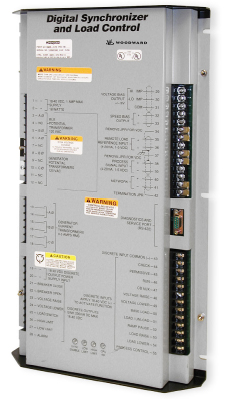Woodward DSLC
Digital Synchronizer and Load Control

Applications
The Woodward DSLC™ control is a microprocessor-based synchronizer and load control designed for use on three-phase AC generators equipped with Woodward or other compatible speed controls and compatible automatic voltage regulators. The DSLC control is a synchronizer, a load sensor, a load control, a dead bus closing system, and optionally a VAR/PF and process control, all integrated into one powerful, yet convenient package. The DSLC control provides either phase matching or slip frequency automatic synchronizing. The DSLC control talks over its own LON (Local Operating Network using Echelon LonWorks® * network technology) to enable safe dead bus closing, and ties into your automatic voltage regulator to match voltages before paralleling.
The DSLC control senses true RMS power and provides bumpless loading and unloading functions. It can either base load or set import/export/process power levels against the utility, and through the DSLC control’s LON, accurately share loads on isolated, multi- engine systems. The optional VAR/PF control is flexible enough to allow you either to provide a set level of VARs to the utility (if this is economical) or to maintain a constant power factor for reliable operation. Through the LON, the VAR/PF control also shares power factors in isolated systems, maintaining proportional reactive loads (kVARs) on all machines more accurately than droop or cross-current voltage systems.
Advantages
• Reduces wiring between synchronizer, load control and automatic loading controls
• Having functions integrated into one box eliminates the need for redundant sensors (like PTs, CTs, and MOPs) that connect to individual modules such as the load sensor and synchronizer
• Hand Held Programmer reduces installation and calibration time by allowing the user to set up the control prior to starting the system
• Hand Held Programmer lets operator monitor generator parameters, contact switches, and analog I/O for installation and troubleshooting
• Reduces the amount of cabinet space needed
• Eliminates the need for additional relay logic or a PLC to control dead bus closing
• Digital communications across the LON reduce susceptibility to noise on the load sharing lines
• Slip frequency paralleling, voltage matching, and speed bias transfer between the synchronizer and load control result in smooth paralleling without the risk of reverse power trips
• Three-phase true RMS power sensing makes the DSLC control accurate even with unbalanced phase loading and voltage fluctuations
• Can load share with Woodward analog controls when used with the Load Sharing Interface Module (8239-082). Refer to Woodward Manual # 02031 for details.
• Synchronizer and load control in one box
• Automatic generator loading and unloading for bumpless load transfer
• Isochronous load sharing with other DSLC-equipped sets
• Process import/export control
• VAR or Power Factor control
• Dead bus closing
• Accurate control of non-linear and distorted generator wave forms
• Digital communications network for information exchange between controls
Operating Modes
Isolated Bus—The DSLC control talks over its LON to share proportional real and reactive loads. Real load (kW) is controlled using percentages of full load for each machine, and reactive loads (kVAR) are shared by matching power factors. The DSLC control maintains a specified bus voltage and frequency while balancing loads.
Utility Parallel—The DSLC control measures real load (kW) on the generator and adjusts the speed control to match a set base load, or to control a process at a user-chosen, externally adjustable set-point. It can be set to a constant import/export level using an MSLC ( Master Synchronizer and Load Control). The DSLC control can also measure and maintain a set reactive load (kVAR) or can maintain a user-prescribed power factor.
Transition Between Modes—The DSLC control will ramp at a user-chosen rate from one mode to another until the control is within 5% of its target. It then shifts into dynamic control, allowing bumpless operating mode changes. In addition, the DSLC control automatically changes its VAR/PF mode when the real load mode is changed to or from an isolated load sharing application. Manual VAR/PF control may also be selected.
Verified 2016 March


